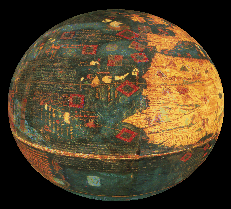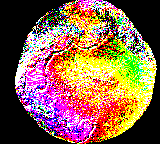
Look to the stars &
listen what they tell you
about our planet
Earth

I do believe that the
Earth is.. flat, a sphere,..

Satellite geodesy for
measurements at our dynamic planet Earth

GPS satellites, used
all over the world, ..

..not only in ocean and
maritime sailing,..

..magnetic compass
(nearly) lost its importance
Geodesy, Surveying, etc.
Ever since man evolved into thinking creature, she has been interested in learning about the Earth. Natural phenomena are often intimately related to the size, shape, gravity field of the Earth, and their time changes, and to understand them requires a certain knowledge of geodesy. For many centuries, the only way to learn about the geometry of the Earth was through astronomy. Together with astronomy, geodesy is among the oldest sciences; it is doubtless the oldest geoscience.
Following the classical definition of Friedrich Robert
Helmert (1880), geodesy is the "science of the measurement and mapping
of the Earth's surface". This definition includes the determination
of the surface of the ocean floor, as well as the Earth's external gravity
field.
Geodesy
(or surveying) may be subdivided into the special disciplines
- geodesy
- plane surveying
- photogrammetry including remote sensing
- cartography
Sometimes geodesy for maritime areas also is called "Marine Geodesy" and it is linked to hydrography.
Geodesy is concerned with the study and measurement of the external shape and gravity field of the solid Earth, the oceans, and the major ice sheets, including their temporal variations. The construction of the Earth's core and mantle as well as the internal dynamics and the exchange of angular momentum between these components are of interest to the section, especially their contribution to changes in Earth's rotation. Geodetic measurements are crucial to the study of climate change, the advance and retreat of ice sheets and glaciers, sea level rise, and charting the motion of the Earth's crust through time. Geodesists are constantly striving for more accurate measurements to complement their existing techniques, and today new, exciting technologies are expanding the possibilities of their research.
Space techniques, such as very long baseline interferometry and laser ranging, which chart positions on Earth with unprecedented accuracy have been applied for more than a decade, but Global Positioning System (GPS) receivers are now being installed for continuous monitoring of crustal motions, especially in seismically active areas. In addition, altimeters carried by satellites and aircraft are being used to monitor ocean topography, including ocean circulation and sea level, as well as variations in the polar ice sheets. The TOPEX/POSEIDON and ERS-1/2 satellites have returned a wealth of information using radar altimetry, and future satellite altimeters will further expand this base.
Satellite geodesy comprises the observational and computational
techniques which allow the solution of geodetic problems by the use of precise
measurements to, from, or between artificial, mostly near-Earth satellites.
Today, the objectives of satellite geodesy mainly are considered in a functional
way, which are
- determination of precise positions
- determination of the Earth's gravity field
- measurement and modelling of geodynamical phenomena
If you still believe geodesy is an enigma, then you should read "Geodesy: The Concepts". The authors Vanicek and Krakiwsky (1986) try, as one of their goals, to work on the demystification of geodesy. Geodesy is not an occult discipline, but a vivid, fascinating, multi-disciplinary science.


